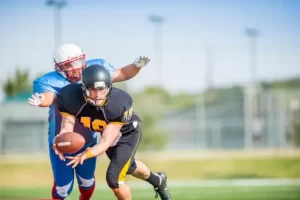n the dynamic and fast-paced game of football, quick decisions and adaptability are crucial for a team’s success. A key aspect of this adaptability lies in the use of audibles and adjustments at the line of scrimmage. The hot route, a quick-hitting passing play, allows teams to exploit defensive weaknesses and make last-second changes to their offensive strategy. What is a Hot Route in Football?
When the quarterback senses that the defense is planning to blitz or has a glaring weakness in coverage, he can call a hot route to change the original play design. This offensive tactic involves the quarterback signaling to one of his receivers to run a short route, enabling a rapid pass to avoid a potential sack. Essentially, the hot route is an essential tool for maintaining offensive momentum and outsmarting the defense on the field.
By mastering the use of the hot route, both quarterbacks and receivers can create significant advantages for their team. Gaining a deeper understanding of this strategic move and its proper execution can make all the difference in turning potential setbacks into game-changing moments.
Contents
What is a Hot Route in Football
A Hot Route in football is a quick-hitting passing play, typically employed when the quarterback identifies an aggressive defense or a potential blitz. The primary objective of a Hot Route is to avoid the blitz and get the ball out of the quarterback’s hands quickly to capitalize on a gap in coverage.
The Hot Route is often initiated through an audible, a last-second change to the original play made at the line of scrimmage. The quarterback senses the need for this alteration upon observing the defense’s pressure or exposed vulnerabilities in coverage.
In a Hot Route scenario, a receiver runs a short route, ensuring that the quarterback can swiftly reach him with a short pass. This can often result in a significant gain in yards, as the aggressive defensive play may leave areas of the field open for exploitation.
Hot Routes also contribute to protecting the health and safety of the quarterback by minimizing the likelihood of a sack. By employing these quick-pass tactics, the offense prevents the defense from penetrating the offensive backfield and reaching the quarterback.
To summarize, Hot Routes serve as strategic tools used by the offense to counteract aggressive defensive tactics, exploit weaknesses in coverage, and ensure the quarterback’s safety on the field.
Types of Hot Routes
Hot routes in football are used to counter blitzes and take advantage of gaps in the defense. They provide quick and efficient passing options for the quarterback. Here are a few examples of popular hot routes:
Slant Route
A slant route is a quick route where the receiver runs at a diagonal angle towards the middle of the field. This route is ideal for creating separation from defensive backs and gaining yards after the catch. Some characteristics of slant routes include:
- Short and fast route
- Typically 3-5 steps before breaking
- Good opportunity for yards after the catch
Hitch Route
A hitch route is a short route where the receiver runs straight downfield and then turns back towards the quarterback. This route is effective against off-man coverage as it creates separation for an easy completion. Characteristics of hitch routes include:
- Requires precise timing
- Creates separation against off-man coverage
- Effective against defensive backs who are playing deep
Out Route
An out route is when the receiver runs straight downfield and then breaks towards the sideline. It is effective against man-to-man coverage and can create separation from the defender. Some features of out routes are:
- Usually run at a depth of 5-10 yards
- Effective against man-to-man coverage
- Can create reliable and easy completions
In Route
An in route, also known as a curl route or a dig route, involves the receiver running downfield and then breaking in towards the middle of the field. This route is effective against zone coverage and can create openings between defenders. Characteristics of in routes include:
- Typically run at a depth of 10-15 yards
- Helps to exploit gaps in zone coverage
- Can lead to big gains after the catch
Fade Route
A fade route is a deep, vertical route where the receiver runs towards the back corner of the end zone. This route is often used in goal-line situations and is effective when the receiver has a height advantage over the defensive back. Features of fade routes include:
- Often used near the goal line
- Requires precise pass from the quarterback
- Effective when the receiver has a height advantage
Reasons to Call a Hot Route
Defensive Blitz
One of the primary reasons to call a hot route in football is to counter a defensive blitz. A blitz occurs when the defense sends additional players to attack the quarterback, attempting to create pressure and achieve a sack. In this situation, the quarterback can identify the incoming blitz and signal one of the receivers to run a short route, known as a hot route. By executing a hot route, the ball is quickly released from the quarterback’s hands, neutralizing the threat of the defensive blitz and minimizing the chance of a sack.
Coverage Recognition
Another reason for calling a hot route is to exploit a weakness in the defensive coverage. The quarterback can analyze the defensive formation and recognize gaps or mismatches that can be taken advantage of with a quick pass to a receiver. When a coverage flaw is detected, the quarterback can call for a hot route that targets the vulnerable area. This can create opportunities for significant gains, as the adjusted route might be able to evade defenders and potentially lead to a big play down the field.
To sum up, a hot route can be an effective offensive tool in football when dealing with defensive blitzes or recognizing weaknesses in coverage. It allows the offense to adapt quickly and exploit opportunities to advance the ball and put pressure on the defense.
How Quarterbacks Communicate Hot Routes
In football, hot routes are quick and simple passing routes used by a quarterback to counter an opponent’s defensive strategy, usually when a blitz is anticipated. Communicating hot routes to teammates is vital in order for the play to be successful. Quarterbacks use a combination of verbal and non-verbal signals to indicate the hot route to their receivers.
Verbal Signals
Verbal signals are audible calls made by the quarterback to notify the receiver of the intended hot route. These calls are usually short, easy to remember, and vary from team to team. Common verbal signals include:
- “Red”: indicating a quick slant route
- “Blue”: signaling a quick out route
- “Green”: calling for a screen pass
It is important for the quarterback and the receivers to have a solid understanding of these verbal signals in order to execute the hot route effectively.
Non-Verbal Signals
Non-verbal signals are another way a quarterback communicates a hot route to the receiver. These include a variety of hand gestures and body movements that the quarterback uses to discreetly convey the hot route without alerting the opposing team. Examples of non-verbal signals are:
- Pointing at the receiver: indicates they are the designated hot route target
- Tapping the helmet: signifies a quick pass
- Tapping the shoulder: suggests a screen pass
Just like with verbal signals, it is crucial for the team to be on the same page regarding the meaning of non-verbal signals to execute the hot route smoothly.
Challenges with Hot Routes
Miscommunication
One of the primary challenges with hot routes in football is the potential for miscommunication between the quarterback and the receiver. Since hot routes are often called as an audible at the line of scrimmage, it is crucial that both players understand the new route and adjust their play accordingly. If either the quarterback or the receiver fails to recognize the hot route signal or misinterprets it, the play is likely to fail or even result in a turnover.
Quick Decision Making
Another challenge associated with hot routes is the requirement for quick decision making by both the quarterback and the receiver. Identifying an impending blitz, the quarterback has to analyze the defensive alignment and make a split-second decision to call a hot route. Similarly, the receiver needs to recognize the hot route call, adjust their route accordingly, and be prepared to receive a quick pass. This rapid decision-making process can sometimes lead to errors in judgment, especially in high-pressure game situations.
Conclusion
A hot route in football is a crucial tactic employed by offenses to counter aggressive defensive plays like blitzes. It involves the quarterback quickly changing a receiver’s route at the line of scrimmage based on what they see from the defense.
Hot routes serve multiple purposes:
- Counter blitzes by getting the ball out of the quarterback’s hands quickly
- Exploit weaknesses in the defensive coverage
- Allow the offense to adjust to unexpected defensive schemes
These quick adjustments help offenses avoid sacks and potentially convert big plays against aggressive defenses.
Understanding and effectively utilizing hot routes can greatly benefit a team’s offensive strategy. While the concept may seem simple, the relationship and communication between the quarterback and receivers are vital to executing hot routes successfully. Practicing these adjustments and building chemistry between the offensive players can significantly improve a team’s ability to adapt to various defensive scenarios on the field.



